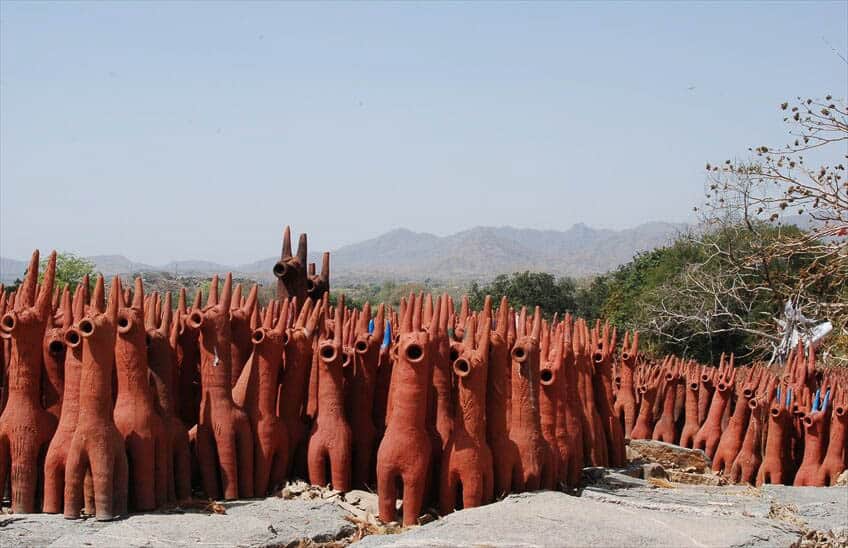
Terracotta votive horses at an Adivasi shrine. Poshina, Gujarat. Image courtesy: vacationindia; see: https://garlandmag.com/article/votive-horses-of-poshina-gujarat/
D Wood reviews two recent novels by Indian writers that evoke the allure of ceramics.
In March 2023, The Guardian published a column entitled, ”Eighty-nine perfect minutes”: 30 of the best short films and novels”. Short novels were defined as being under about 200 words. Had I been selected to nominate a best short novel I would have stretched the rule to 209 pages on behalf of The Earth Spinner.
Why acclaim Anuradha Roy’s novel? Well, obviously, because it’s about craft! The topic of craft is rarely considered in fiction: it is researched, observed and discussed at arm’s length in non-fiction. Novelists are not usually makers so one that is brings insight and resonance to her tale.
Anuradha is a ceramist and before writing this review I contacted her to learn the extent of her potting. She replied:
I started making pots when I was a student at Cambridge in the 1990s but began to learn formally when I came to Delhi in 1994. My first teacher was Bani De Roy, by then quite elderly. She had been a student of Shoji Hamada. After a couple of years with her, I learned for three years at the Delhi Blue Pottery, and then went to the US to stay with and learn from Jeff Diehl of Lockbridge Studio in West Virginia. He is now a sort of long-distance teacher for me.
I can’t say I am a professional or high-level potter—no, not at all. I think of myself as a perpetual student. I make pots because I am happy when I’m making them. Mostly I make things for use around my own house, or for friends. Because of the vagaries of electricity in the Himalaya, I only have a small electric kiln. (I do not have enough wood for wood firing, nor enough gas for gas firings.)
I do have a website from which I sell what little I make, and the proceeds all go to a dog charity in the mountains where I live. It is a bit haphazard—I work in the studio in spurts; for many months it might be every day, with many firings a month; and then for weeks, I may not be able to go there at all because of my writing or publishing work (my husband and I run a publishing house together).
Thus, The Earth Spinner follows the dictum, write what you know. Anuradha has written a story of India and the West, caste and intolerance, and love and loss centred on clay.
The opening and closing chapters of The Earth Spinner are written as a diary. The author is Sarayu whose location is London where she is attending university as a consequence of a scholarship for worthy Muslim girls. Her discipline is English literature with which she is barely coping due to loneliness, impecunity and the abominable English climate. Sarayu finds refuge in a church basement near her college that is kitted out with everything a potter could dream of. She says: “I feel as if I’ve dropped into a secret cave through a rabbit hole – where the lights stay on, the kilns, tools and wheels are tended by elves who do their work unseen, where stocks of material are magically replenished, and you can come in at any time of day or night” (5-6). It’s free for students including tea bags and “fat, chewy ginger cookies.”
Sarayu comes to the ceramic studio with experience. Her home is in a neighbourhood called Kummarapet in the Indian state of Andhra Pradesh, named after the kummara, or potters, for which the area was known. The kummara were a vital part of the community and economy in the past, making household items as well as religious icons. Now the only remaining purveyor, Elango, carries on his grandfather’s tradition, producing goods for wholesalers: earthen lamps, gods and goddesses, water pitchers, curd pots, flowerpots and tea glasses. However, his major income is generated from gigantic urns that his college friend orders for up-scale hotels.
Elango also operates an auto-rickshaw in which he ferries six children to school. These include Sarayu and her sister Tia. At the age of 10, Sarayu expresses interest in clay and Elango shows her how to model ducks and rabbits; by the age of 12, she has her own wheel built by her father and Elango. The set-up in Elango’s studio is light years away, both geographically and psychically, from the premises that Sarayu knows in London. His wheel “lay at floor level and was made with wood and clay that was fashioned into a heavy disk balanced upon a grooved stone. He would turn the disk very fast with a stick and once it began spinning it was like a top: it straightened and kept spinning” (19). The space is the back verandah of a turquoise house surrounded by a yard of rammed earth.
The diary bookends of The Earth Spinner enclose a tale that includes star-crossed lovers—Hindu and Muslim—an adored foundling dog, intolerant neighbour and blind calligrapher. They all come together, for good and evil, as Elango makes a large clay horse that replicates the ones made by his ancestors for an annual religious festival. The former horses were divine; Elango’s horse is otherworldly, inspired by his dreams and forbidden love.
I won’t reveal more of the story. Suffice it to say, this volume is a best short novel not only because of its immersion in craft. The Earth Spinner is humorous, captivating, informative and sensual. To wit:
A fiery breath of air blew a shower of small dry leaves from the moringa tree onto my wet clay and a crow appeared in the courtyard, its beak wide open with thirst. Along with the crow came a butterfly, blue-black, huge-winged, so close I could feel it stir up the air near my face. It dipped and floated, fluttered at a speed that made its wings evaporate as it hung suspended over my water bowl, then hovered above my face, my clay. I shut my eyes and felt it settle on my cheeks. Its feet moved across my face as weightless as a whisper” (93-94).
Perhaps the book is too short. The reader wants to linger longer.
Coincidentally, another Indian author highlights craft, not as extensively as Anuradha Roy does, but enough that it’s worthy of mention. Salman Rushdie’s novel, Victory City, was well on its way to bookshelves before he was attacked in August 2022. The book is about a narrative poem written in Sanskrit by Pampa Kampana, and discovered by the narrator after being buried in a clay pot for four and a half centuries. Pampa Kampana tells the story of the Bisnaga Empire in a poem of twenty-four thousand verses called Jayaparajaya, translated as “Victory and Defeat” (3).
The narrator, unnamed, does the honours of interpreting the Jayaparajaya for the reader. Pampa’s father (he died while she was young), according to her mother, had been kind and well-loved. He was a potter in the town of Kampili and “had encouraged his wife to learn the potter’s art as well, so after he died she took over his trade and proved more than his equal” (6). Mother taught daughter such that, by the age of nine, Pampa was skilled at making pots and bowls and had learned that dictates about gender exclusivity re certain tasks was poppycock. In the future, she would establish a matriarchy.
The bad news is that Pampa’s anticipation of life as a potter was dashed as a nine-year-old; the good news is that she received a “celestial blessing” whereby she acquired an alter ego who was a goddess and lived for 250 years to chronicle her Empire in the Jayaparajaya. Needless to say, this is a fantastical tale with princes, concubines, battles, a good many elephants, and a wicked mother-in-law. Pampa becomes very busy in her role as human/goddess/scribe and doesn’t practice potting again until late in her life. But Salman’s descriptions of the environment, beginning in fourteenth century India/Bharat/Hindustan when artisanry was the norm, are redolent of craft:
“Household servants and aides, dressed in such finery as was appropriate for those who served a king—cockaded turbans, brocaded coats, shoes that curled up at their toes, necklaces, and rings” (24).
“He was escorted by expressionless women warriors past ornamental pools and splendid baths, past stone reliefs of marching soldiers and saddled elephants, past stone girls with flared skirts dancing in stone unison beside musicians drumming on stone drums and playing sweet melodies on flutes of stone. Above these friezes the walls were lined with silken cloths onto which pearls and rubies had been sewn, and there were golden lions standing in the corners” (81).
“… you will see everywhere in Our palace the exceptional bidri handicrafts of Bidar—the boxes and hookahs and vases and closets made of blackened copper and zinc and inlaid with the most delicate silver traceries and designs … “ (225).
Victory City conjures images of handcrafted riches and splendour. Salman’s saga of mediaeval India is also an anachronism. Apart from the fact that, in portions, women rule, the instantaneous shift from 500 years ago to now can’t but provoke laughs. For instance, the cast of characters includes a family of brothers—Hukka, Bukka, Pukka, Chukka and Dev (a parody on Curly, Larry and Moe?)—one of whom responds to a proposed plan with “sounds good”. Another brother has zits. And when the man who “was escorted by expressionless women” is asked for advice, he says, “This isn’t my portfolio” (90).
Anuradha Roy and Salman Rushdie enhance the realm of literature by recognising and featuring the realm of artisanry. The craft community should thank them for highlighting our passion.
References
Anuradha Roy, The Earth Spinner (New York: HarperVia, 2022) ISBN 978-0-06-322068-3
Salman Rushdie, Victory City (Toronto: Alfred A, Knopf, 2023) ISBN 9781039000551


